China and Covid19
Fangcang Diaries: China’s Makeshift Covid Hospitals, from Wuhan to the Future
Fangcang hospitals are here to stay as long as China sticks to its current zero-Covid path.
Published
2 years agoon
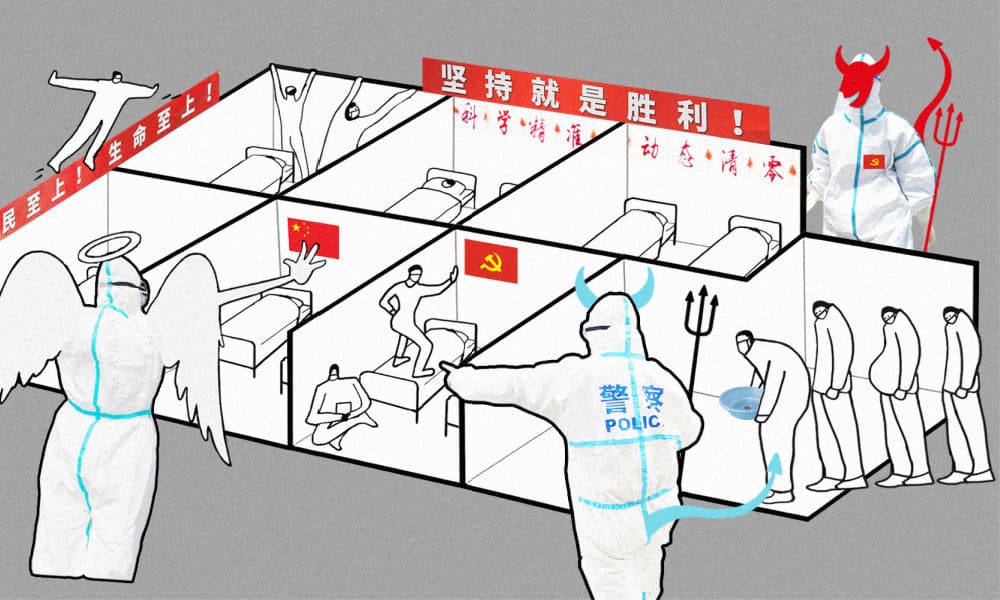
By mid 2020, many thought Fangcang, China’s Covid-19 makeshift hospitals, had become a thing of the past. Instead, they have become a part of the country’s future. Through the course of the pandemic, perceptions of China’s ‘square cabin’ Covid hospitals have drastically changed. Chinese social media users get a glimpse of life inside the Fangcang hospitals thanks to patients’ online diaries, videos, and photos.
This is the “WE…WEI…WHAT?” column by Manya Koetse, original publication in German by Goethe Institut China, visit Yi Magazin: Fangcang ohne Ende: Chinas Covid-Krankenhäuser damals und heute.
In February of 2020, the impressive construction of two enormous emergency field hospitals in Covid-stricken Wuhan captured the world’s attention. The Huoshenshan and Leishenshan Hospitals were constructed in a matter of days and combined they could take in 2,500 patients. The construction process was live-streamed by state media and sped-up drone footage of a large empty field transforming into a fully functioning hospital received millions of clicks around the internet.
Along with mass-testing and local lockdowns, the so-called ‘Fangcang’ shelter hospitals are seen as a key solution in ‘fighting Covid-19 the Chinese way’ to alleviate the pressure on public hospitals and lower Covid-19 mortality rates by quarantining and treating patients with confirmed infections.
Within a matter of 2,5 years, Fangcang emerged as a novel concept on China’s coronavirus battleground and then became a part of everyday life in a zero Covid society. Here, we will zoom in on China’s Fangcang phenomenon and changes in the public’s perceptions of it.
MORE THAN MASH: THE NOVEL FANGCANG CONCEPT
Fāngcāng (方舱) literally means ‘square cabin,’ referring to a modular or prefabricated mobile cabin hospital. Although the concept of an emergency field hospital or makeshift hospital is not new, Fangcang hospitals are labeled as a “novel public health concept” due to their specific use during China’s Covid crisis (Chen et al 2020).
Some studies say that China’s Covid-19 Fangcang hospitals were modeled after emergency cabins used during the Wenchuan and Yushu earthquakes in 2008 and 2010 (Wang et al 2020, 2). According to the biggest Chinese-language online encyclopedia, Baidu Baike, the term actually comes from the United States, where the U.S. Army first started developing such cabins – Mobile Army Surgical Hospitals (MASH units) – in the early 1950s and used them during the Korean War. The Chinese Fangcang hospital, however, is not really the same and the concept was implemented for the first time in Wuhan in February 2020.

Aerial view of the American 46th MASH unit (photo by Robert L. Emanuele, published at https://bulletin.facs.org/)
In China, Fangcang hospitals are large, temporary hospitals for the isolation, treatment, and disease monitoring of Covid-19 patients with mild-to-moderate symptoms. By taking in and quarantining people who have tested positive for Covid-19, they are meant to reduce the transmission of the virus within households and communities, while also providing treatment to patients with mild symptoms (Fang et al 2020, 2). In doing so, they dramatically reduce the pressure on regular hospitals, which need their beds to solely treat patients with severe and critical conditions.
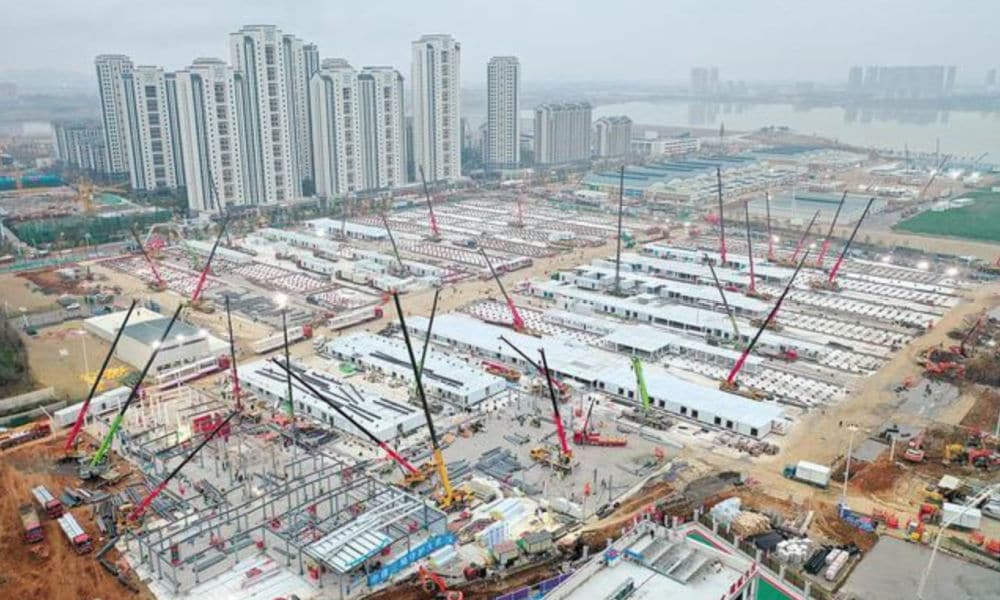
Construction of Huoshenshan Hospital, image via Sohu.com.
The 1,000-bed Huoshenshan Hospital (火神山医院) was constructed within a matter of days, starting on January 23, 2020, and ending on February 2. The first patients were admitted a day later. The construction of the 1,500 bed Leishenshan Hospital (雷神山医院) started on the 26th of January and was completed on 6 February 2020.
Many other Fangcang hospitals were not constructed like these shelter hospitals but were built by converting large (public) buildings such as exhibition centers, stadiums, or schools into healthcare facilities. In Wuhan, over a dozen more Fangcang hospitals were opened in February of 2020 to provide beds for Covid-19 patients before all being suspended on March 10 of that year when the crisis was under control.
FANGCANG ON SOCIAL MEDIA: A CHANGING IMAGE
In the early stages of the pandemic, Chinese social media users got a glimpse of life inside the Fangcang hospitals through official media videos and through footage and photos posted by people staying there. Up to the present day, patients share their quarantine experiences on social media using hashtags such as “Fangcang Diaries” (#方舱日记#).
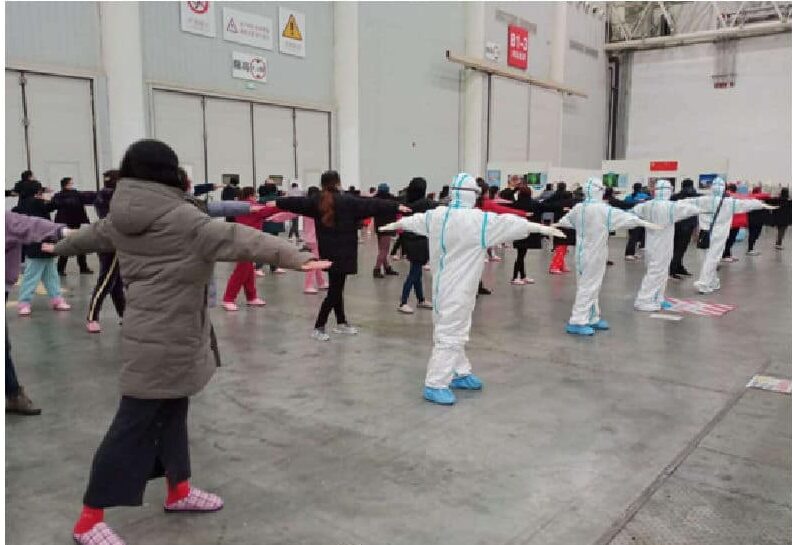
Medical workers leading a dance exercise session for COVID-19 patients at a Fangcang in Wuhan, March 2020. Photo posted on Weibo (@滨州文旅).
In the Wuhan days, there were videos of patients dancing together inside the hospitals, with people cheering on the positivity of patients and the dedication of the healthcare workers.

Photo posted from a Wuhan Fangcang by Weibo user (@121314人生需要转折) on February 29, 2020.
One photo of a patient reading Francis Fukuyama’s The Origins of Political Order even went viral on Weibo. Many admired the patient for reading such heavy literature during his Fangcang stay and the man became famous overnight as ‘the invincible Wuhan-er.’

The Invincible Wuhan-er, see more here.
A young woman known as A Nian (阿念) also wrote on social media about her quarantine stay at one of Wuhan’s Fangcang hospitals in February of 2020. When her grandmother fell critically ill during her stay at the city’s Huoshenshan hospital, A Nian asked to be transferred to the same Fangcang so that she could take care of her. Despite having A Nian by her side, the grandmother passed away. A Nian’s experiences at the Wuhan Fangcang hospitals were eventually published in the book Wuhan Girl A Nian Diary (武汉女孩阿念日记). The book paints a picture of the Fangcang where resilience, warmth, and optimism dominate the overall atmosphere.
The Covid-19 outbreak in Wuhan was a national war against the virus, and the Fangcang hospitals were described and represented as a necessary and praised tool within this united fight. The medical staff members working there were the heroes on the frontline, and many social media users honored and thanked them for their efforts.
After the shelter hospitals in Wuhan gradually closed, the social media focus shifted to how the Covid crisis became a pandemic and caused chaos in the rest of the world. By April of 2020, Wuhan had returned to a state of normalcy, and schools across the country reopened. When Huoshenshan and Leishenshan closed their doors, Fangcang soon seemed to become a thing of the past.
Although there were local outbreaks of Covid-19 in China throughout 2020 and 2021, the Fangcang hospitals did not really return to the public spotlight until Xi’an saw cases spike in late 2021 and early 2022, with the city becoming the epicenter of the biggest Covid outbreak and lockdown since Wuhan.
By January of 2022, the city of Xi’an had started to construct large sites for isolation of people who tested positive for Covid-19, in addition to designated hospitals. Besides ‘Fangcang,’ these were also called ‘Centralized Isolation Points’ (集中隔离点).
As later explained by Dr. Wu Jinglei, director of Shanghai Municipal Health Commission, Fangcang hospitals can also be used as ‘Isolation Points.’ The two are the same but using ‘Isolation Point’ instead of ‘Fangcang Hospital’ emphasizes the need to also isolate and observe patients who are asymptomatic at these health locations, besides treating those with mild-to-moderate symptoms. Later on, these locations also started to be referred to as ‘Fangcang Isolation Points’ (方舱隔离点) or ‘Isolation Fangcang’ (隔离方舱).
One story that attracted major attention on Chinese social media and indicated changing perceptions of the Fangcang phenomenon was the midnight eviction of residents of the Xi’an Mingde 8 Yingli community (明德八英里小区) in Xi’an. Just after midnight on January 1st of 2022, residents received news that they would be transferred by buses, and quarantined away from their compound due to new infections in their proximity.
Residents voiced their concerns on social media about the incident, saying they were unsure of where they were heading, and that they were put in buses together for hours until being driven off to a remote Fangcang without proper supplies. The term ‘bèi lāzǒu’ (被拉走) was used, ‘being dragged away.’
Old people, young children, and pregnant women were among those being taken away for quarantine without being provided with the things they needed, and without any measures to protect them against the dangers of infection. An image of an old man with a walking cane standing in line to be taken away for quarantine went viral online as many worried about his wellbeing. He was seemingly all alone and did not seem to have any luggage or food supplies with him.
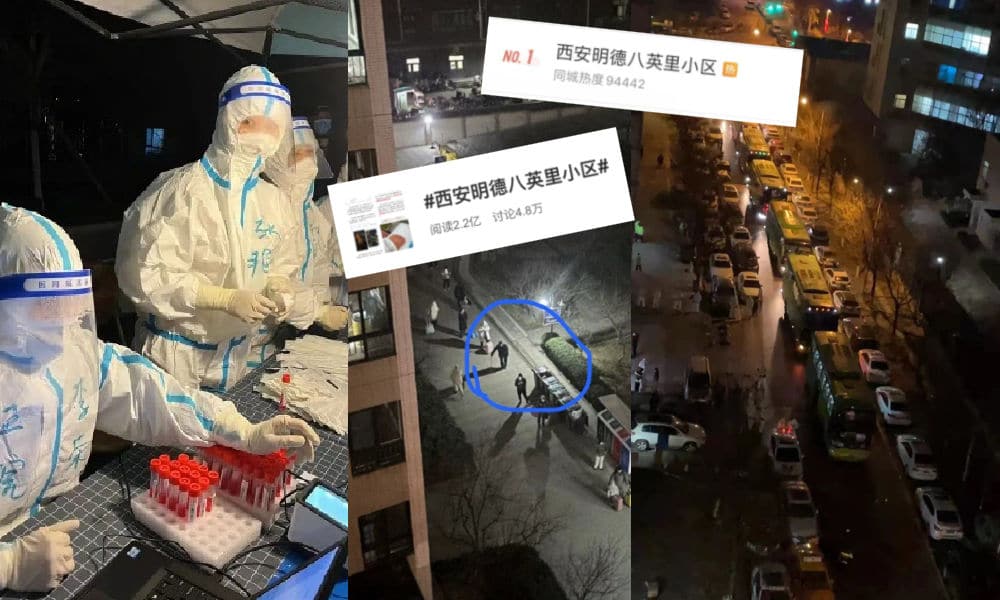
Seeing photos of old buildings without proper facilities being turned into Fangcang, many residents wondered what the point of this kind of isolation was. One popular post by a Weibo user nicknamed ‘In Between Memories’ from January 2nd of 2022 said:
“I don’t understand why negative-tested families should be dragged away for isolation? Isn’t isolation at home also isolation? The Fangcang hospitals were built to focus on treating the mildly ill, separately from the seriously ill. But nowadays, after discovering one positive case, Xi’an wants to pull away the entire neighborhood to a centralized quarantine with poor conditions – even if everyone has already been in home quarantine for over a week. Is this all just so that Xi’an can say it has zero infections while ignoring the scientific basis that many families tested negative multiple times? While disregarding the special needs of families with elderly, young, sick, disabled, and pregnant people? Before transferring people, you never provided them with a policy basis, nor was there any warning or reminder given to the citizens of Xi’an that you would implement [this policy] on the spot in the middle of the night. Now that everyone is at risk, perhaps some will support this, hoping that there can be zero cases within the community in a time frame of three days. But there are more residents who are only worried that the next one to be dragged away will be them. After all, we will be taken away even if we stay well at home and test negative ten times for the nucleic acid test, what about the elderly and our children, what about our pets? No one cares, they only care about their hard target to clear the city of Covid within three days.”
Within three weeks of lockdown, Xi’an was the first city to have so many patients admitted to Isolation Points: nearly 50,000 people were isolated at 443 different Fangcang quarantine locations across Xi’an (Southern Weekend 2022).

January 5 2022, a Fangcang or Isolation Point with over 1000 separate isolations rooms is constructed in Baqiao District of Xi’an (Image via Renmin Shijue).
The fears of being taken away to Fangcang hospitals and Isolation Points also became a reality for Shanghai residents after an unprecedented Covid-19 spike in the city, starting in March of 2022. As the city entered a phased lockdown, photos and videos of a local quarantine site where babies and small children were kept in isolation – separated from their parents – went viral on Chinese social media.1
Not long after, patients at Fangcang hospitals started posting on social media about their experiences, complaining that there was a lack of basic supplies, that they were not given the medicine they needed, and that vulnerable patients were left to their own devices without proper care.
As the Covid-19 cases continued to spike throughout March and April, videos also started surfacing showing chaotic scenes at some Fangcang sites in Shanghai where patients were fighting over supplies such as blankets, water, and food, some crying when they were unable to get anything but some bottles of water – or nothing at all.
The apparent disorganization at quarantine facilities from the city’s Pudong to Minhang Districts triggered discussions on Chinese social media about why asymptomatic patients were taken off to these ill-equipped centralized Fangcang locations at all and why they were not allowed to isolate at home instead.
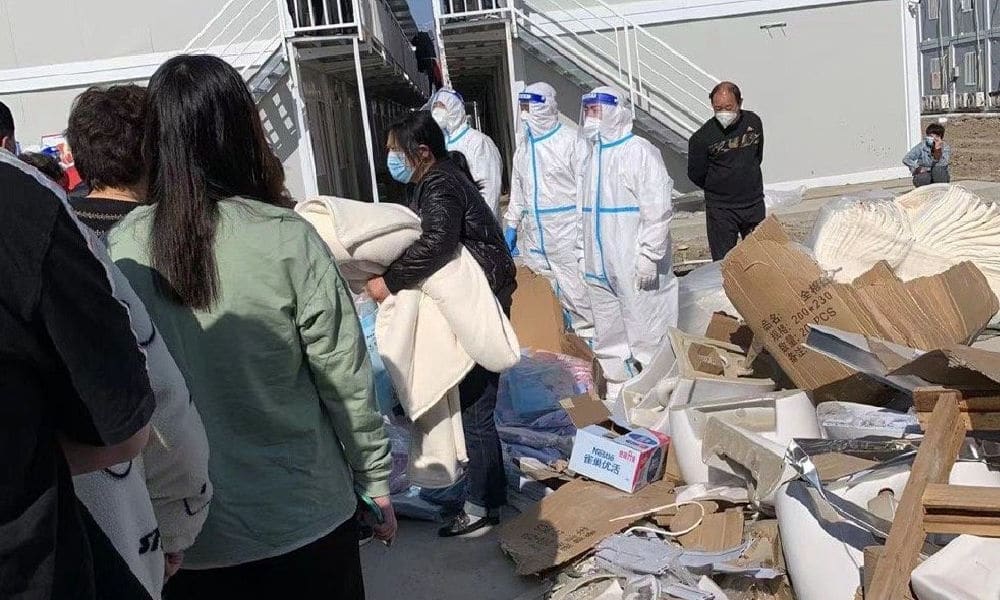
Chaotic situation at a quarantine location in Shanghai’s Pudong in early April 2022 (video).
One Weibo user wrote in April 2022:
“They took us to an isolation site. If the conditions had just been a bit better, we’d be okay with it, but this is just unimaginable. These are the facts. Over 800 people have entered this facility since April 9, their ages varying from seventy or eighty years old to babies just a few months old. 1. Inside the factory building, there are plank beds without mattresses, there are no people to clean. 2. There is no supervisor, we need to fight over our food. 3. There are not enough supplies, not even enough toilet paper. 4. 80% of the toilets are clogged, there’s nobody to clean them. 5. There are no doctors and nobody to take care of patients with a fever. 6. There is no one to dispose of the garbage. 7. The weather’s hot, but there’s no place to shower or change clothes.”
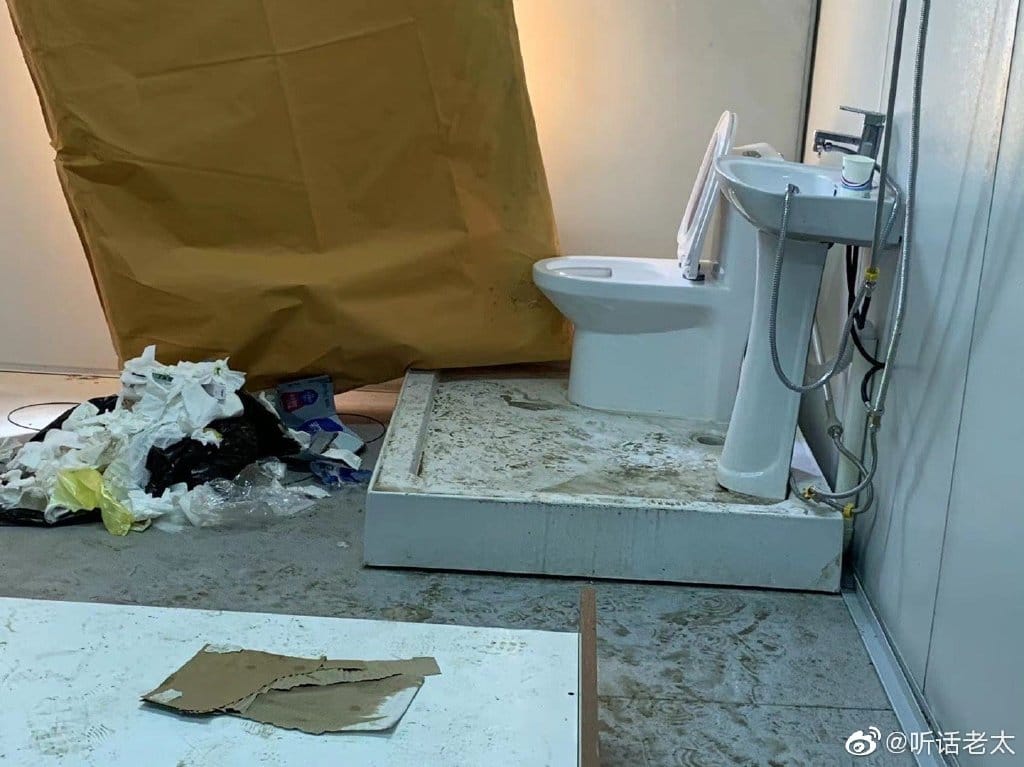
Patients shared a photo of the toilets at one Pudong quarantine location (more here).
Stories also started coming out of patients being taken away to Isolation Points many days after they had first tested positive for Covid. By the time they were finally taken away for quarantine, they had recovered and tested negative for Covid-19, yet still had to go and stay together with patients testing positive.
To create more beds for patients, Shanghai opened China’s largest-ever Fangcang hospital on April 8 at the National Exhibition Convention Center. This Fangcang, built by the same people who had helped build Huoshenshan and Leishenshan in Wuhan, had a capacity of 50,000 beds for Covid-19 patients.
These bigger, modern, and central Fangcang locations are generally neat and orderly, providing regular meals and medicine, as well as offering various activities or even setting up classrooms for quarantined students.
But photos, footage, and online diaries posted on social media exposed the stark differences in living conditions between different Fangcang hospitals. By late April of 2022, patients staying at one Fangcang location in the city’s Putuo District – an office building converted into a makeshift hospital – complained about the crowded living conditions, the lack of washing rooms and showers, and the inadequate supply of food and drinking water. At other facilities, patients posted videos of water pouring into the building after heavy rain.

Wide-angle view of the Shanghai office buildings that have been converted to Fangcang hospitals (What’s on Weibo).

Inside the office converted into Fangcang, photo via Weibo.
From Wuhan in 2020 to Shanghai in 2022, the public perception of the Fangcang phenomenon in China changed dramatically. While it was initially seen as an effective, efficient, and celebrated response to the outbreak of Covid, many Shanghai-based residents, during the peak of the city’s Covid crisis, feared the Fangcang more than the virus itself, as stories about overcrowded, disorganized and unequipped facilities kept surfacing online.
THE FUTURE OF FANGCANG
By mid-May of 2022, after seeing over 60,000 confirmed Covid-19 cases in total, Shanghai retired half of its Fangcang locations due to rapidly declining cases. Nevertheless, the restrictions to keep Covid under control are still stringent.
As Chinese leadership remains adamant on sticking with its zero-Covid strategy, state media emphasize the need to uphold the mandatory quarantine system as part of this public health policy, which basically means the country will not opt to ‘live with the virus’ but instead will continue to implement strict measures to eliminate a Covid outbreak as fast as possible once it emerges.
Fangcang are here to stay as long as China stays on its current zero-Covid path. The country’s top epidemiologist Liang Wannian (梁万年) maintains that patients need to be isolated at a centralized location because they can be easily monitored and treated that way, while also minimizing the risks of them spreading the virus to others in their household or community.
In preparation for potential future outbreaks, cities across China are building new Fangcang or are improving existing ones. Authorities are making sure that the country is ready to manage more local outbreaks, avoiding messy Fangcang scenes like the ones in Xi’an or Shanghai.
On May 13, China’s National Health Commission called on all provinces to build or renovate city-level Fangcang hospitals, and to make sure they are equipped with electricity, ventilation systems, medical appliances, toilets, and washing facilities.
The country-wide Fangcang preparation plan is now in full swing. In Zhengzhou, for example, construction workers are building a new Fangcang from the ground up. The city of Zhoukou recently issued a promo video on Weibo showing off their local brand-new Fangcang location with 356 private rooms equipped with air disinfection systems, private showers, and free Wi-Fi. Meanwhile, Shanghai even introduced its first Fangcang location for pets.
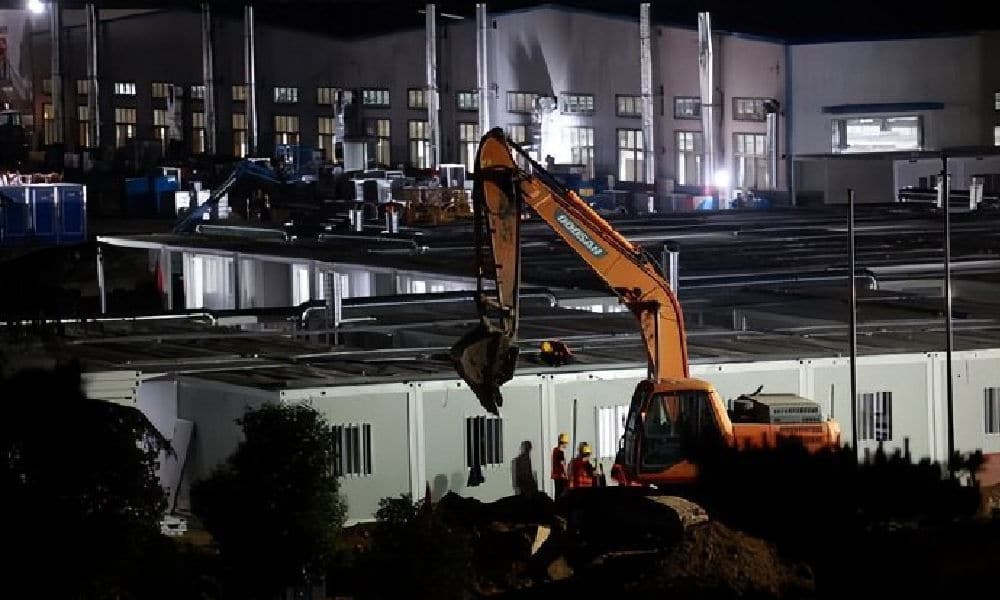
Zhengzhou’s new Fangcang, construction work in mid-May 2022 (Weibo via @顶端新闻).
When it was announced that China would withdraw as the 2023 Asian Cup host due to the pandemic, netizens joked that the stadiums constructed for the sports event could now be turned into Fangcang instead.
“The Fangcang will become a regular facility in the next few years,” some social media users commented. Others wrote: “This is good news. It’s better to be prepared for what’s coming,” and: “Better to prepare to build the Fangcang now than to prepare to build our future graves.”

Weibo user sharing photo from one Shanghai Fangcang (@路漫漫的碎碎念)
Generally, despite worries over a lack of medical care and supplies at facilities, many people do support the idea of their cities being prepared for an immediate Covid response once it’s necessary. “I don’t get why people are being negative about building new Fangcang,” one Weibo user from Hebei Province writes:
“People think that they should stay home if they get infected but want other people to quickly go away to a Fangcang hospital if they’re sick. Our little town is now also building a Fangcang, and I think it’s a good thing. Before, there were too many infections in the neighboring village, and they took them for isolation to the hotel in our city center and all stores in the vicinity had to close. (..) It was scary, people didn’t want to visit the center anymore. Now, they’re building a Fangcang at the town border, away from the people, and it’s a relief for all of us.”
Meanwhile, Fangcang patients keep sharing their journals online. “Today is day seven for me,” one Shanghai resident wrote on Weibo: “I finally had an egg for the first time here. I’ve been constipated all week (..) This morning, I heard I meet the conditions to be discharged [two negative tests in a row], but due to the lack of capacity I’m still waiting, and it might still take two or three more days before I get to go home.”
“It’s day twelve. I can’t wait until I’m released from ‘prison’,” one person wrote.

Kids playing inside a Shanghai Fangcang Isolation Point, pictured shared on Weibo.
“It’s my first night at the Fangcang,” one Weibo user writes in another online ‘Covid journal’: “There’s too much light and noise, and my dad and I took turns in waking up. Eventually, he decided to get up, thinking it was 5 am, until we discovered it was just past 2 am. I felt light-headed as I headed to the bathroom.”
One patient at another Shanghai Fangcang writes: “My stay at the Fangcang is better than I had expected. I am sleeping better than at home and don’t have to think about what I am going to eat. But there are many elderly people inside here, and I see them suffering. I’m not sure if this policy really helps them.” They also write: “I’d better record all of this. I think this is going to be an experience I’ll remember for the rest of my life.”
By Manya Koetse
Follow @whatsonweibo
1 On April 6, 2022, Shanghai changed the policy and announced that parents can apply to accompany their children during central quarantine after signing an agreement, regardless of whether they’ve tested positive for the virus or not.
References (other sources linked to inside the text)
Chen, Simiao Chen, Zongjiu Zhang, Juntao Yang, Jian Wang, Xiaohui Zhai, Till Bärnighausen, Chen Wang. 2020. “Fangcang Shelter Hospitals: A Novel Concept for Responding to Public Health Emergencies.” The Lancet, April 2 https://www.thelancet.com/journals/lancet/article/PIIS0140-6736(20)30744-3/fulltext [May 12, 2022].
Fang, Dongpin, Shengjie Pan, Zaishang Li, Ting Yuan, Benran Jiang, Di Gan, Bai Sheng, Jing Han, Tao Wang, Zhongmin Liu. 2020. “Large-Scale Public Venues as Medical Emergency Sites in Disasters: Lessons from COVID-19 and the Use of Fangcang Shelter Hospitals in Wuhan, China.” BMJ Global Health 5: 1-7.
Luo, Hanbin, Jiajing Liu, Chengqian Li, Ke Chen, Ming Zhang. 2020. “Ultra-Rapid Delivery of Specialty Field Hospitals To Combat COVID-19: Lessons Learned from the Leishenshan Hospital Project in Wuhan.” Automation in Construction 119 (103345): 1-10.
Southern Weekend 南方周末. 2022. “The Largest Centralized Quarantine: 49,678 People in nearly One Month, What Has Xi’an Invested 最大规模集中隔离:近一月49678人,西安付出了什么” [In Chinese]. Sina News, January 13 https://news.sina.cn/2022-01-13/detail-ikyamrmz4934227.d.html [May 13].
Wang, Ke-Wei, Jie Gao, Xiao-Xiao Song, Jiang Huang, Hua Wang, Xiao-Long Wu, Qin-Fang Yuan, Xiao-Shan Li, Feng Cheng, Yang Cheng. 2020. “Fangcang Shelters Are a One Health Approach for Responding to the Covid-19 Outbreak in Wuhan, China.” One Health 10 (100167): 1-6.
Featured image by Ama for Yi Magazin.
This text was written for Goethe-Institut China under a CC-BY-NC-ND-4.0-DE license (Creative Commons) as part of a monthly column in collaboration with What’s On Weibo.
Spotted a mistake or want to add something? Please let us know in comments below or email us. First-time commenters, please be patient – we will have to manually approve your comment before it appears.
Manya Koetse is the founder and editor-in-chief of whatsonweibo.com. She is a writer, public speaker, and researcher (Sinologist, MPhil) on social trends, digital developments, and new media in an ever-changing China, with a focus on Chinese society, pop culture, and gender issues. She shares her love for hotpot on hotpotambassador.com. Contact at manya@whatsonweibo.com, or follow on Twitter.

China and Covid19
Sick Kids, Worried Parents, Overcrowded Hospitals: China’s Peak Flu Season on the Way
“Besides Mycoplasma infections, cases include influenza, Covid-19, Norovirus, and Adenovirus. Heading straight to the hospital could mean entering a cesspool of viruses.”
Published
8 months agoon
November 22, 2023
In the early morning of November 21, parents are already queuing up at Xi’an Children’s Hospital with their sons and daughters. It’s not even the line for a doctor’s appointment, but rather for the removal of IV needles.
The scene was captured in a recent video, only one among many videos and images that have been making their rounds on Chinese social media these days (#凌晨的儿童医院拔针也要排队#).
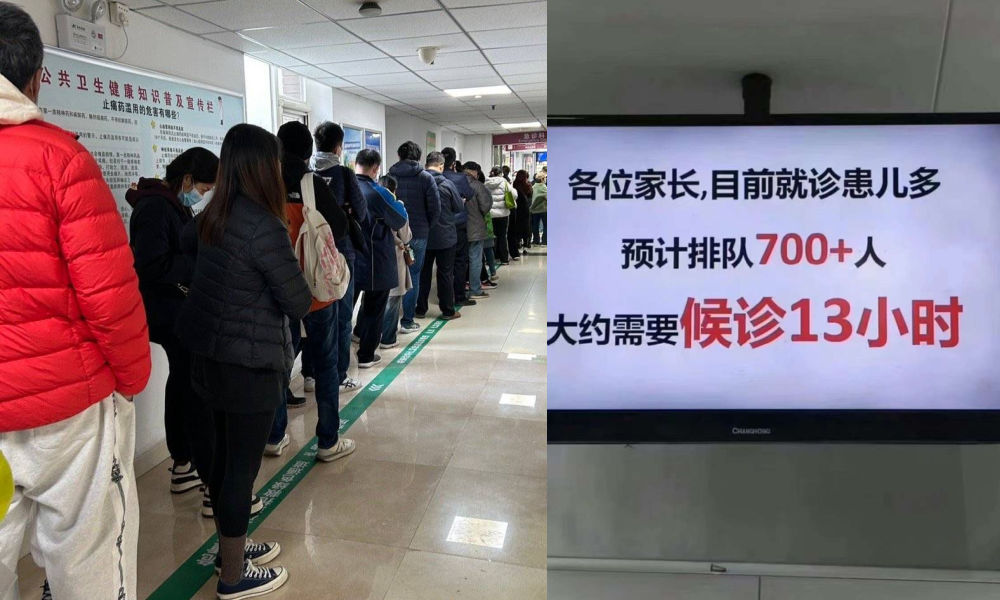
One photo shows a bulletin board at a local hospital warning parents that over 700 patients are waiting in line, estimating a waiting time of more than 13 hours to see a doctor.
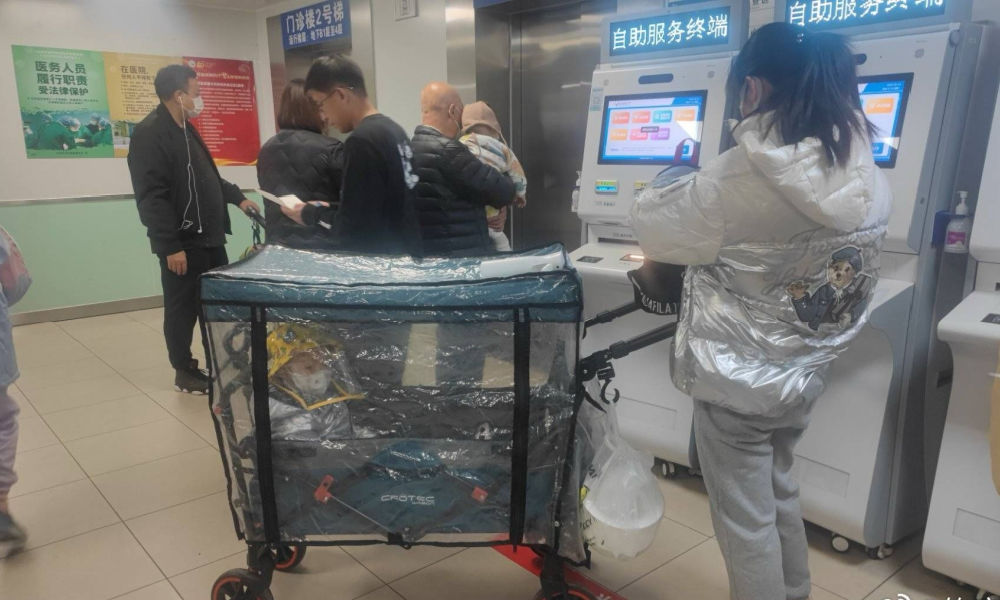
Another image shows children doing their homework while hooked up on an IV.

Recent discussions on Chinese social media platforms have highlighted a notable surge in flu cases. The ongoing flu season is particularly impacting children, with multiple viruses concurrently circulating and contributing to a high incidence of respiratory infections.
Among the prevalent respiratory infections affecting children are Mycoplasma pneumoniae infections, influenza, and Adenovirus infection.
The spike in flu cases has resulted in overcrowded children’s hospitals in Beijing and other Chinese cities. Parents sometimes have to wait in line for hours to get an appointment or pick up medication.
According to one reporter at Haibao News (海报新闻), there were so many patients at the Children’s Hospital of Capital Institute of Pediatrics (首都儿科研究所) on November 21st that the outpatient desk stopped accepting new patients by the afternoon. Meanwhile, 628 people were waiting in line to see a doctor at the emergency department.
Reflecting on the past few years, the current flu season marks China’s first ‘normal’ flu peak season since the outbreak of Covid-19 in late 2019 / early 2020 and the end of its stringent zero-Covid policies in December 2022. Compared to many other countries, wearing masks was also commonplace for much longer following the relaxation of Covid policies.
Hu Xijin, the well-known political commentator, noted on Weibo that this year’s flu season seems to be far worse than that of the years before. He also shared that his own granddaughter was suffering from a 40 degrees fever.
“We’re all running a fever in our home. But I didn’t dare to go to the hospital today, although I want my child to go to the hospital tomorrow. I heard waiting times are up to five hours now,” one Weibo user wrote.
“Half of the kids in my child’s class are sick now. The hospital is overflowing with people,” another person commented.
One mother described how her 7-year-old child had been running a fever for eight days already. Seeking medical attention on the first day, the initial diagnosis was a cold. As the fever persisted, daily visits to the hospital ensued, involving multiple hours for IV fluid administration.
While this account stems from a single Weibo post within a fever-advice community, it highlights a broader trend: many parents swiftly resort to hospital visits at the first signs of flu or fever. Several factors contribute to this, including a lack of General Practitioners in China, making hospitals the primary choice for medical consultations also in non-urgent cases.
There is also a strong belief in the efficacy of IV infusion therapy, whether fluid-based or containing medication, as the quickest path to recovery. Multiple factors contribute to the widespread and sometimes irrational use of IV infusions in China. Some clinics are profit-driven and see IV infusions as a way to make more money. Widespread expectations among Chinese patients that IV infusions will make them feel better also play a role, along with some physicians’ lacking knowledge of IV therapy or their uncertainty to distinguish bacterial from viral infections (read more here)
To prevent an overwhelming influx of patients to hospitals, Chinese state media, citing specialists, advise parents to seek medical attention at the hospital only for sick infants under three months old displaying clear signs of fever (with or without cough). For older children, it is recommended to consult a doctor if a high fever persists for 3 to 5 days or if there is a deterioration in respiratory symptoms. Children dealing with fever and (mild) respiratory symptoms can otherwise recover at home.
One Weibo blogger (@奶霸知道) warned parents that taking their child straight to the hospital on the first day of them getting sick could actually be a bad idea. They write:
“(..) pediatric departments are already packed with patients, and it’s not just Mycoplasma infections anymore. Cases include influenza, Covid-19, Norovirus, and Adenovirus. And then, of course, those with bad luck are cross-infected with multiple viruses at the same time, leading to endless cycles. Therefore, if your child experiences mild coughing or a slight fever, consider observing at home first. Heading straight to the hospital could mean entering a cesspool of viruses.”
The hashtag for “fever” saw over 350 million clicks on Weibo within one day on November 22.
Meanwhile, there are also other ongoing discussions on Weibo surrounding the current flu season. One topic revolves around whether children should continue doing their homework while receiving IV fluids in the hospital. Some hospitals have designated special desks and study areas for children.
Although some commenters commend the hospitals for being so considerate, others also remind the parents not to pressure their kids too much and to let them rest when they are not feeling well.
Opinions vary: although some on Chinese social media say it's very thoughtful for hospitals to set up areas where kids can study and read, others blame parents for pressuring their kids to do homework at the hospital instead of resting when not feeling well. pic.twitter.com/gnQD9tFW2c
— Manya Koetse (@manyapan) November 22, 2023
By Manya Koetse, with contributions from Miranda Barnes
Get the story behind the hashtag. Subscribe to What’s on Weibo here to receive our newsletter and get access to our latest articles:
Spotted a mistake or want to add something? Please let us know in comments below or email us. First-time commenters, please be patient – we will have to manually approve your comment before it appears.
©2023 Whatsonweibo. All rights reserved. Do not reproduce our content without permission – you can contact us at info@whatsonweibo.com.
China and Covid19
Repurposing China’s Abandoned Nucleic Acid Booths: 10 Innovative Transformations
Abandoned nucleic acid booths are getting a second life through these new initiatives.
Published
1 year agoon
May 19, 2023
During the pandemic, nucleic acid testing booths in Chinese cities were primarily focused on maintaining physical distance. Now, empty booths are being repurposed to bring people together, serving as new spaces to serve the community and promote social engagement.
Just months ago, nucleic acid testing booths were the most lively spots of some Chinese cities. During the 2022 Shanghai summer, for example, there were massive queues in front of the city’s nucleic acid booths, as people needed a negative PCR test no older than 72 hours for accessing public transport, going to work, or visiting markets and malls.
The word ‘hésuān tíng‘ (核酸亭), nucleic acid booth (also:核酸采样小屋), became a part of China’s pandemic lexicon, just like hésuān dìtú (核酸地图), the nucleic acid test map lauched in May 2022 that would show where you can get a nucleic test.
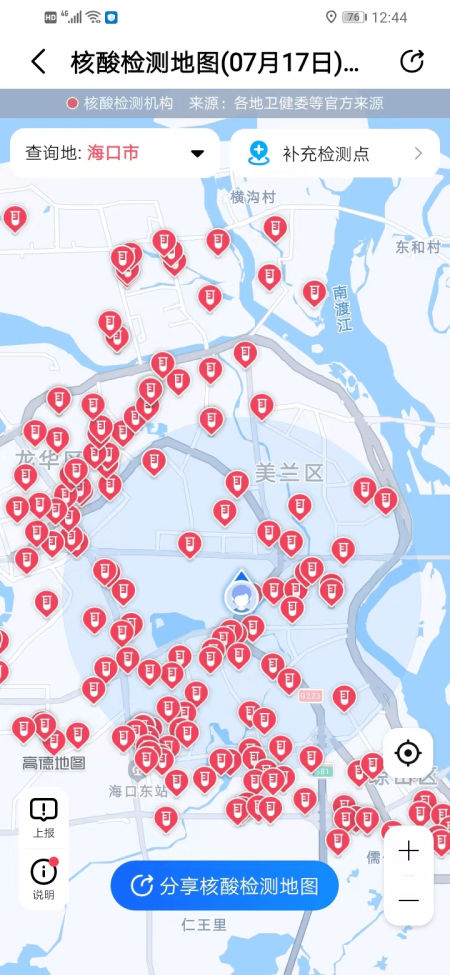
Example of nucleic acid test map.
During Halloween parties in Shanghai in 2022, some people even came dressed up as nucleic test booths – although local authorities could not appreciate the creative costume.
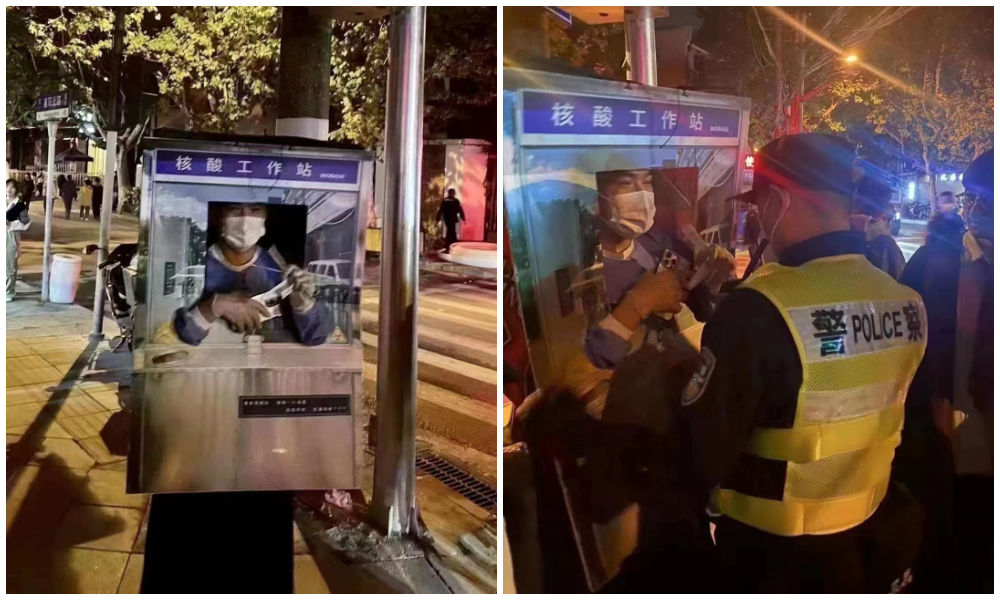
Halloween 2022: dressed up as nucliec acid booths. Via @manyapan twitter.
In December 2022, along with the announced changed rules in China’s ‘zero Covid’ approach, nucleic acid booths were suddenly left dismantled and empty.
With many cities spending millions to set up these booths in central locations, the question soon arose: what should they do with the abandoned booths?
This question also relates to who actually owns them, since the ownership is mixed. Some booths were purchased by authorities, others were bought by companies, and there are also local communities owning their own testing booths. Depending on the contracts and legal implications, not all booths are able to get a new function or be removed yet (Worker’s Daily).
In Tianjin, a total of 266 nucleic acid booths located in Jinghai District were listed for public acquisition earlier this month, and they were acquired for 4.78 million yuan (US$683.300) by a local food and beverage company which will transform the booths into convenience service points, selling snacks or providing other services.
Tianjin is not the only city where old nucleic acid testing booths are being repurposed. While some booths have been discarded, some companies and/or local governments – in cooperation with local communities – have demonstrated creativity by transforming the booths into new landmarks. Since the start of 2023, different cities and districts across China have already begun to repurpose testing booths. Here, we will explore ten different way in which China’s abandoned nucleic test booths get a second chance at a meaningful existence.
1: Pharmacy/Medical Booths
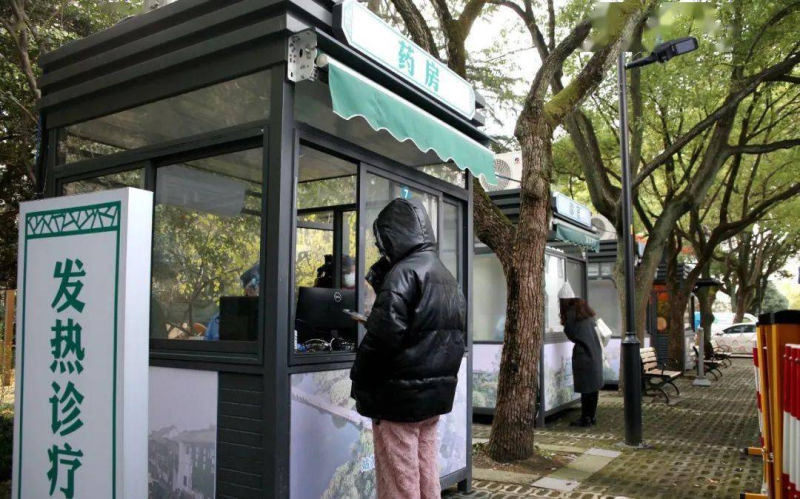
Via ‘copyquan’ republished on Sohu.
Blogger ‘copyquan’ recently explored various ways in which abandoned PCR testing points are being repurposed.
One way in which they are used is as small pharmacies or as medical service points for local residents (居民医疗点). Alleviating the strain on hospitals and pharmacies, this was one of the earliest ways in which the booths were repurposed back in December of 2022 and January of 2023.
Chongqing, Tianjin, and Suzhou were among earlier cities where some testing booths were transformed into convenient medical facilities.
2: Market Stalls
In Suzhou, Jiangsu province, the local government transformed vacant nucleic acid booths into market stalls for the Spring Festival in January 2022, offering them free of charge to businesses to sell local products, snacks, and traditional New Year goods.
The idea was not just meant as a way for small businesses to conveniently sell to local residents, it was also meant as a way to attract more shoppers and promote other businesses in the neighborhood.
3: Community Service Center
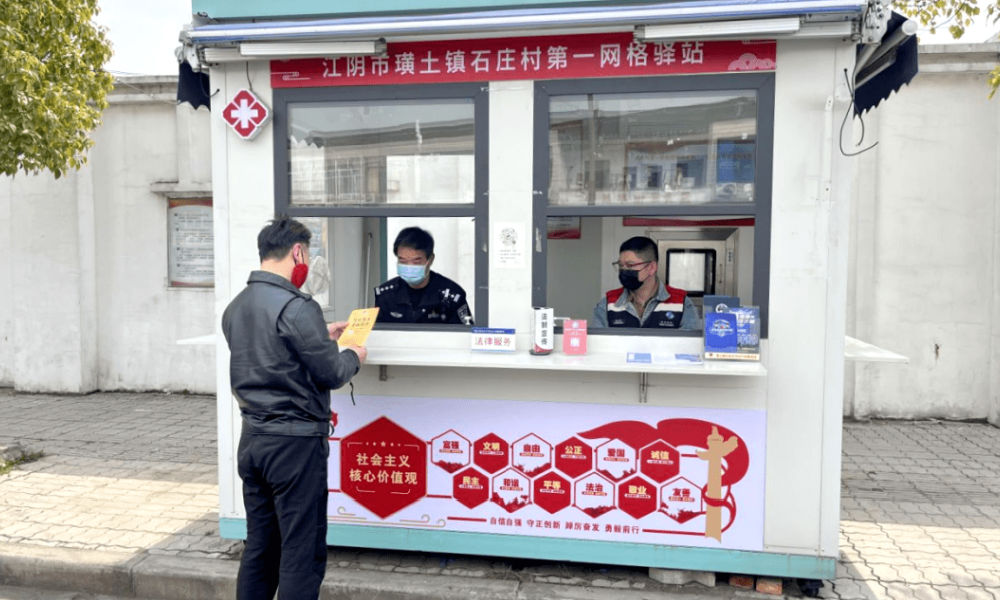
Small grid community center in Shizhuang Village, image via Sohu.
Some residential areas have transformed their local nucleic acid testing booths into community service centers, offering all kinds of convenient services to neighborhood residents.
These little station are called wǎnggé yìzhàn (网格驿站) or “grid service stations,” and they can serve as small community centers where residents can get various kinds of care and support.
4: “Refuel” Stations
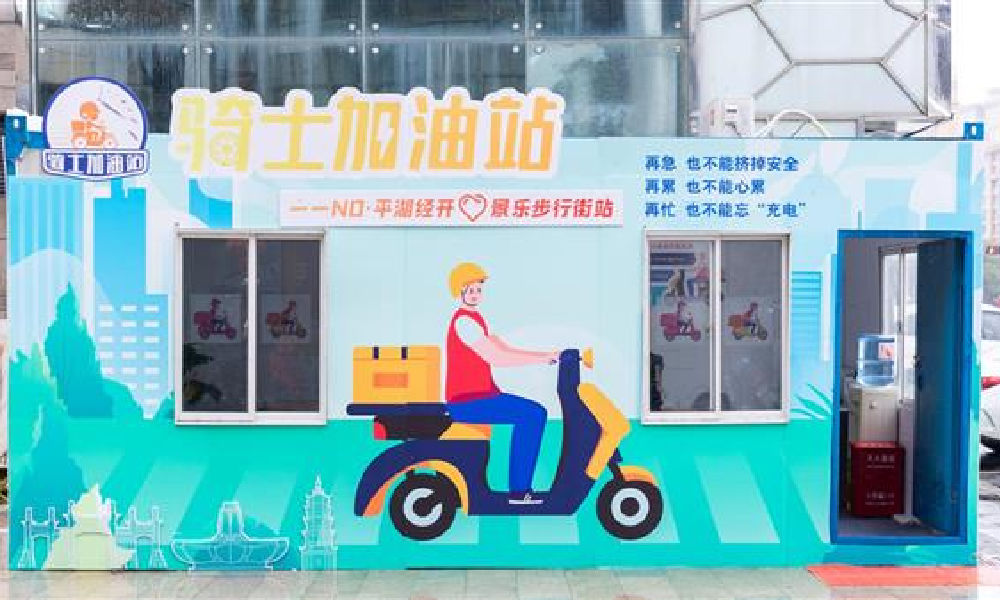
In February of this year, 100 idle nucleic acid sampling booths were transformed into so-called “Rider Refuel Stations” (骑士加油站) in Zhejiang’s Pinghu. Although it initially sounds like a place where delivery riders can fill up their fuel tanks, it is actually meant as a place where they themselves can recharge.
Delivery riders and other outdoor workers can come to the ‘refuel’ station to drink some water or tea, warm their hands, warm up some food and take a quick nap.
5: Free Libraries
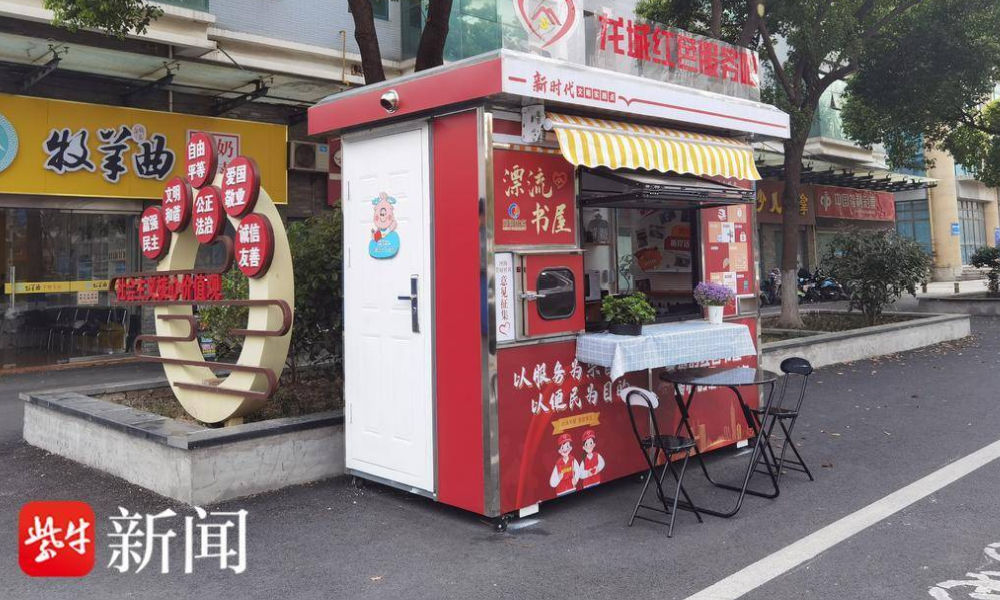
image via sohu.
In various Chinese cities, abandoned nucleic acid booths have been transformed into little free libraries where people can grab some books to read, donate or return other books, and sit down for some reading.
Changzhou is one of the places where you’ll find such “drifting bookstores” (漂流书屋) (see video), but similar initiatives have also been launched in other places, including Suzhou.
6: Study Space

Photos via Copyquan’s article on Sohu.
Another innovative way in which old testing points are being repurposed is by turning them into places where students can sit together to study. The so-called “Let’s Study Space” (一间习吧), fully airconditioned, are opened from 8 in the morning until 22:00 at night.
Students – or any citizens who would like a nice place to study – can make online reservations with their ID cards and scan a QR code to enter the study rooms.
There are currently ten study booths in Anji, and the popular project is an initiative by the Anji County Library in Zhejiang (see video).
7: Beer Kiosk

Hoegaarden beer shop, image via Creative Adquan.
Changing an old nucleic acid testing booth into a beer bar is a marketing initiative by the Shanghai McCann ad agency for the Belgium beer brand Hoegaarden.
The idea behind the bar is to celebrate a new spring after the pandemic. The ad agency has revamped a total of six formr nucleic acid booths into small Hoegaarden ‘beer gardens.’
8: Police Box
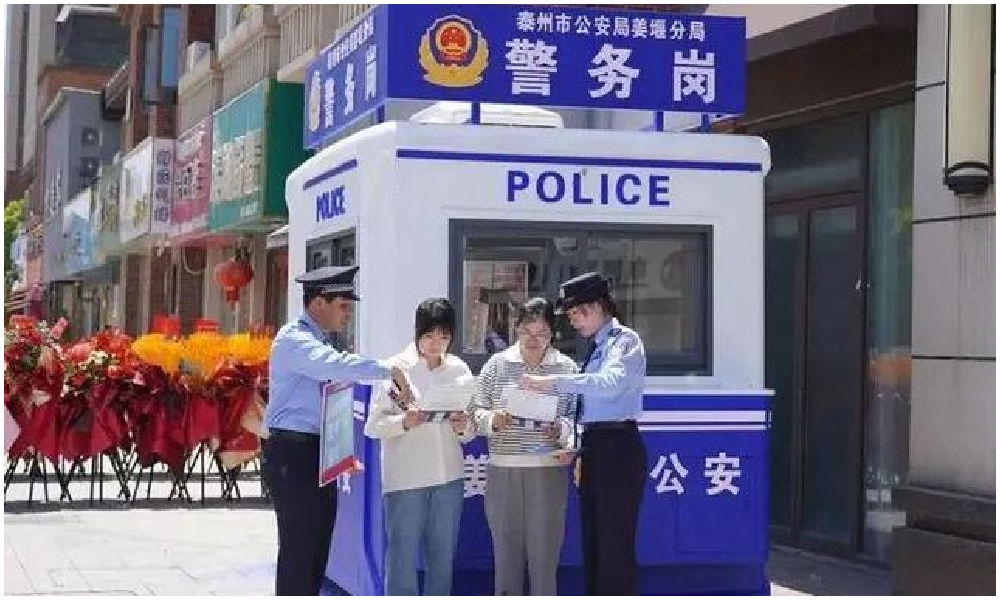
In Taizhou City, Jiangsu Province, authorities have repurposed old testing booths and transformed them into ‘police boxes’ (警务岗亭) to enhance security and improve the visibility of city police among the public.
Currently, a total of eight vacant nucleic acid booths have been renovated into modern police stations, serving as key points for police presence and interaction with the community.
9: Lottery Ticket Booths
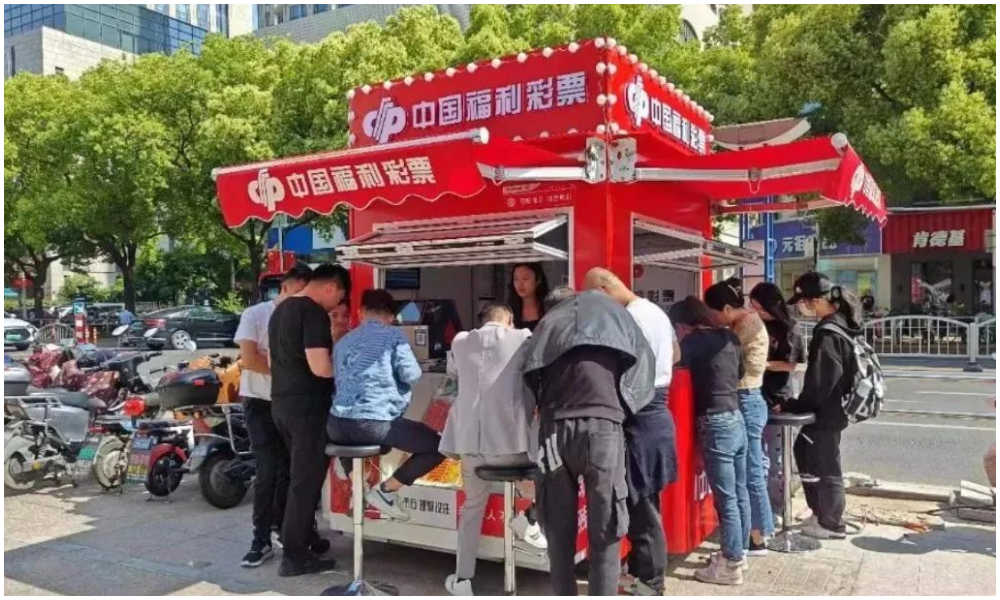
Image via The Paper
Some nucleic acid booths have now been turned into small shops selling lottery tickets for the China Welfare Lottery. One such place turning the kiosks into lottery shops is Songjiang in Shanghai.
Using the booths like this is a win-win situation: they are placed in central locations so it is more convenient for locals to get their lottery tickets, and on the other hand, the sales also help the community, as the profits are used for welfare projects, including care for the elderly.
10: Mini Fire Stations

Micro fire stations, images via ZjNews.
Some communities decided that it would be useful to repurpose the testing points and turn them into mini fire kiosks, just allowing enough space for the necessary equipment to quickly respond to fire emergencies.
Want to read more about the end of ‘zero Covid’ in China? Check our other articles here.
By Manya Koetse,
Get the story behind the hashtag. Subscribe to What’s on Weibo here to receive our newsletter and get access to our latest articles:
Spotted a mistake or want to add something? Please let us know in comments below or email us. First-time commenters, please be patient – we will have to manually approve your comment before it appears.
©2023 Whatsonweibo. All rights reserved. Do not reproduce our content without permission – you can contact us at info@whatsonweibo.com.
Subscribe

Weibo Watch: The Future is Here

“Bye Bye Biden”: Biden’s Many Nicknames in Chinese

Enjoying the ‘Sea’ in Beijing’s Ditan Park

A Triumph for “Comrade Trump”: Chinese Social Media Reactions to Trump Rally Shooting

Weibo Watch: Get Up, Stand Up

The Tragic Story of “Fat Cat”: How a Chinese Gamer’s Suicide Went Viral

“Old Bull Eating Young Grass”: 86-Year-Old Chinese Painter Fan Zeng Marries 36-Year-Old Xu Meng

A Brew of Controversy: Lu Xun and LELECHA’s ‘Smoky’ Oolong Tea

Singing Competition or Patriotic Fight? Hunan TV’s ‘Singer 2024’ Stirs Nationalistic Sentiments

Zara Dress Goes Viral in China for Resemblance to Haidilao Apron

Weibo Watch: The Battle for the Bottom Bed

About the “AI Chatbot Based on Xi Jinping” Story

China’s Intensified Social Media Propaganda: “Taiwan Must Return to Motherland”

Weibo Watch: Telling China’s Stories Wrong

Saying Goodbye to “Uncle Wang”: Wang Wenbin Becomes Chinese Ambassador to Cambodia
Get in touch
Would you like to become a contributor, or do you have any tips or suggestions? Get in touch here!
Popular Reads
-

 China Insight3 months ago
China Insight3 months agoThe Tragic Story of “Fat Cat”: How a Chinese Gamer’s Suicide Went Viral
-

 China Music4 months ago
China Music4 months agoThe Chinese Viral TikTok Song Explained (No, It’s Not About Samsung)
-

 China Digital10 months ago
China Digital10 months agoToo Sexy for Weibo? Online Discussions on the Concept of ‘Cābiān’
-

 China Arts & Entertainment12 months ago
China Arts & Entertainment12 months agoBehind 8 Billion Streams: Who is Dao Lang Cursing in the Chinese Hit Song ‘Luocha Kingdom’?






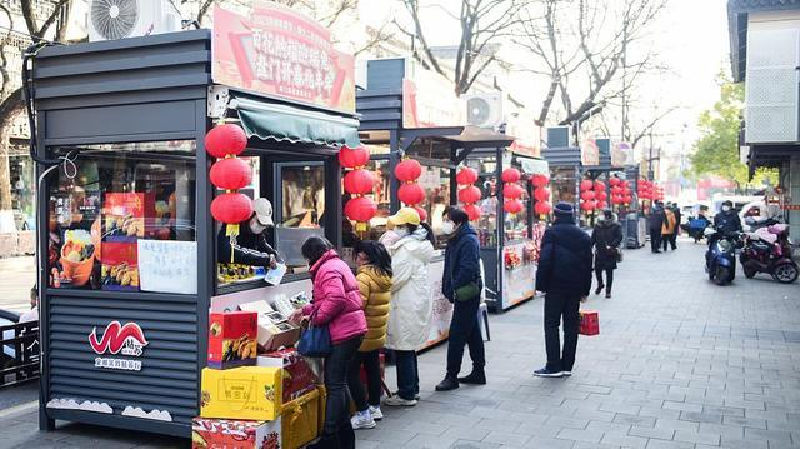

Guest
July 1, 2022 at 8:44 am
I worked in hospitals, and even by Chinese standards these places have nothing in common with a hospital. They should be called what they are: prisons.